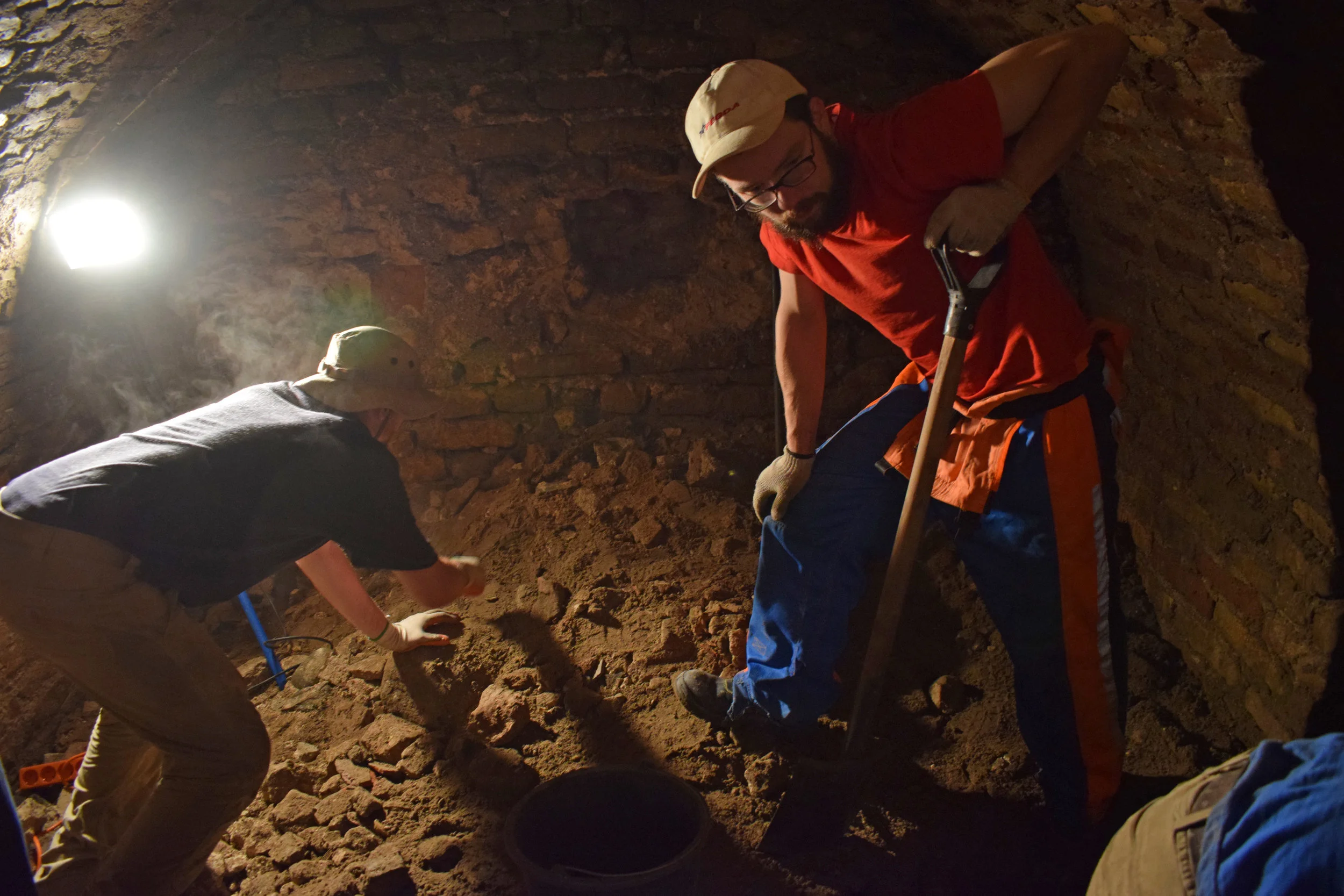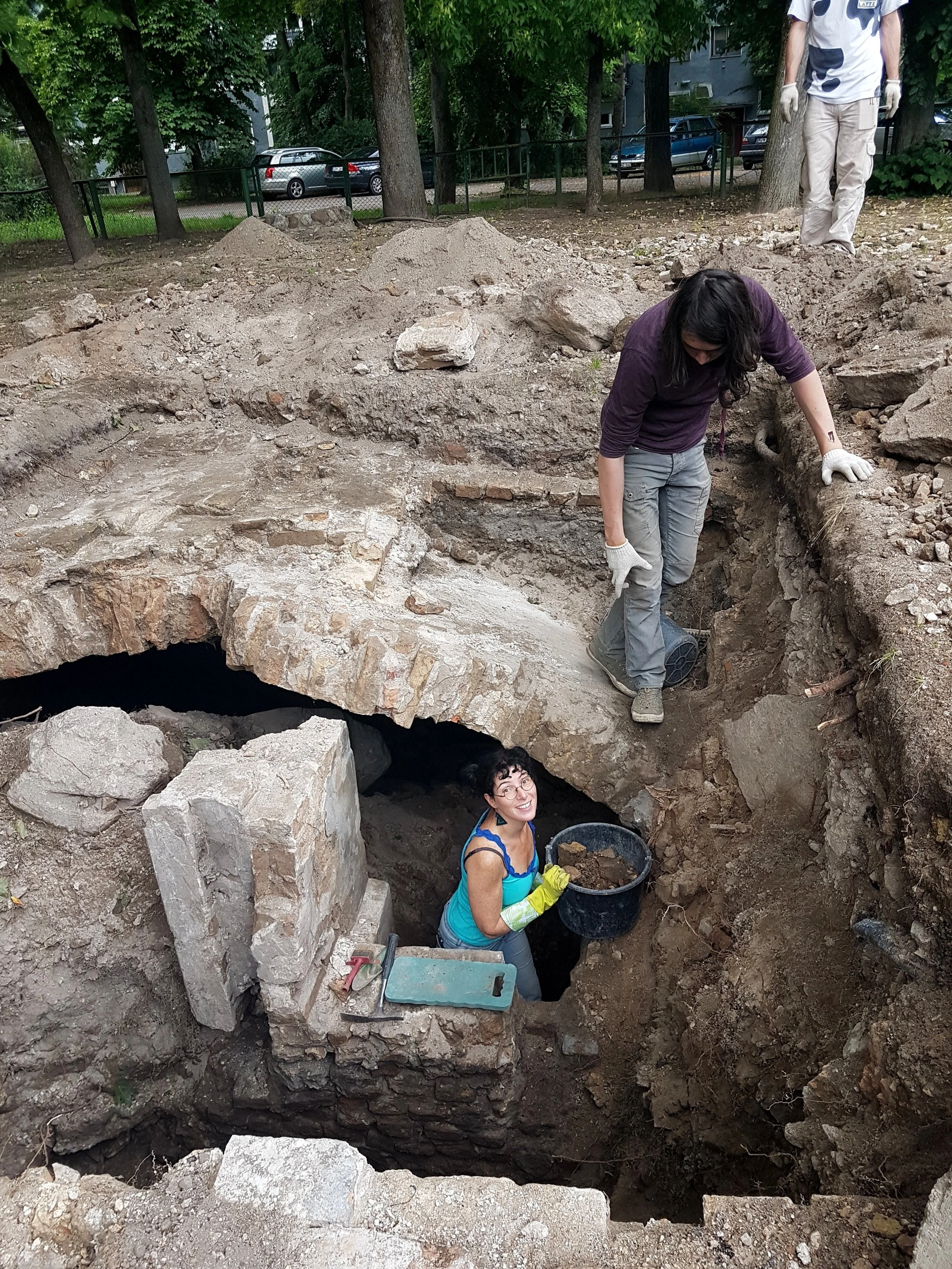Archaeologists discover inscription in Lithuanian synagogue, part of ornate Bimah.
Built in the 17th century, the Great Synagogue of Vilna served Latvic Jewry until it was destroyed during the Holocaust. A joint project to excavate and conserve the Synagogue is being carried out by the Israel Antiquities Authority (IAA), Kultūros paveldo Išsaugojimo pajėgos, the Goodwill Foundation and the Jewish Community of Lithuania. Last summer excavations revealed part of the Synagogue’s Bimah, where the Torah was read. This year, when uncovering more of the magnificent Bimah, excavators were excited to find an extensive Hebrew inscription.
Dr. Jon Seligman of the IAA and Justinas Račas of the Kultūros paveldo Išsaugojimo pajėgos of Lithuania have conducted excavations in Lithuania every summer for the last four years. "The large and significant inscription,” they say, “…was part of a stone Torah reading table that stood on the magnificent Bimah of the synagogue in Vilnius.” Dating to 1796, the table would have been in use for about 200 years before the synagogue’s final destruction by the Soviets 70 years ago.
According to the inscription, the table was donated by two brothers - Rabbi Eliezer and Rabbi Shmuel, in memory of their mother, Sarah, and their father, Rabbi Chaim. The text notes that their father had emigrated from Lithuania to Israel and settled in Tiberias. Dr. Vladimir Levin of the Hebrew University of Jerusalem worked together with Seligman and Račas to interpret the inscription, which reads as follows:
“In the year “Raise us with joy to our country” [=1796]. [This Torah reading table] was donated by R. Eliezer and R. Shmuel, the sons of R. Chaim who lived in Tiberias, be it rebuilt and reestablished soon in our days. ”And died Sarah” [Gen. 23:2] our mother, the daughter of R. Shabbtai, on the 4th of Adar “I gave to Jerusalem a messenger of good news” [Is. 41:27] [=1782] and our father R. Chaim son of R. Chaim died there on the 7th of Nissan “arise and have mercy on Zion” [Ps. 102:14] [=1786].”
3D visualization of the Great Synagogue of Vilna. Video: Inlusion Visual Studios
After their preliminary investigation of this inscription, reachers believe the donor family was one of the leading rabbinical families in Lithuania at the beginning of the 18th century. However, because no family name is mentioned in the text, there is some mystery surrounding the inscription, and it is unknown who the family was that donated the stone table. Researchers are calling on the public to help complete the pieces of the puzzle by providing any information about the family through the project’s Facebook page.
“The project of exposing the historic Great Synagogue of Vilna is part of the IAA’s ‘Heritage without Borders’ concept, which also includes the research of sites outside the borders of the State of Israel. This arises from the perception that the IAA was entrusted by the Israeli public to serve as the ‘watchtower’ on its behalf for the protection of heritage and cultural asset.”
The plaque of the director of the "Tzedaka Gedola" association. Photo: John Seligman, Courtesy of the IAA
A second inscription was also discovered, a seating plaque for the head of the "Tzedaka Gedola" association. The Tzedaka Gedola association managed the Great Synagogue of Vilna from the end of the 18th century until 1931. "These are the discoveries that fascinate us most” researchers say. “It is the personal objects that provide a direct connection to people, to those who prayed here, that immediately ignites the imagination.”
While the inscriptions are certainly highlights of this year’s excavation the Bimah itself is also beautiful discovery. Originally two stories tall, the Bimah was constructed in the 18th century with funds donated by the well-known Jewish philanthropist, the Yesod. According to the researchers, "the decorative Baroque Bimah, which was documented in photographs from the early 20th century, was a two-story structure set between four magnificent pillars that supported the ceiling. Between these columns, and on the front of the Bimah, a cantor read the Torah to the congregation for 300 years.” Excavations surrounding the Bimah revealed a elegant terrazzo floor and a large cellar beneath the Bimah. Among the finds recovered during the excavation were a prayer book that survived the Holocaust, hundreds of coins from the 16th to 20th centuries and buttons of Napoleon's army, which passed through Vilnius on its way to defeat in Moscow in 1812.
Excavations at The Great Synagogue will continue, and in time researchers hope these stunning remains will be presented and made accessible to the public.
Abby VanderHart, FIAA Contributor









